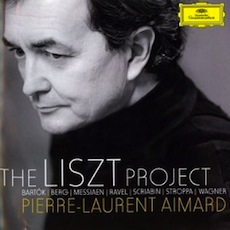
One of the tributes to this year’s 200th anniversary of the birthday of Franz Liszt is this two-CD recording by the French pianist Pierre-Laurent Aimard (Deutsche Grammophon). As is always the case with Aimard’s programs, the selection of music in this recording, which lasts for more than two hours, is exceedingly well thought out.
Liszt, of course, was celebrated for his stunning virtuosity, but on these discs, the listener won’t hear Liszt the scintillating showman. There are no rhapsodies, no études (transcendental or otherwise), and no dazzling piano transcriptions; this is Liszt the visionary. The recording reveals hidden threads and draws stylistic connections between Liszt and other composers: Wagner, Berg, Scriabin, Ravel, Bartók, Stroppa, and Messiaen.
Liszt’s one-movement Sonata in B Minor inspired one-movement sonatas by Wagner, Berg, and Scriabin (all present on disc 1). Liszt’s “Saint François d’Assise: La Prédication aux oiseaux” from Années de Pélègrinage III is bathed in impressionistically shimmering air, delicate chirping, and fluttering wings, anticipating Marco Stroppa’s “Tangata manu” from Miniature estrose (1959). These two pieces are cleverly juxtaposed on disc 2. Another of Liszt’s preimpressionistic pieces, Les Jeux d’eau à la Villa d’Este, directly foreshadows the water ripples of Ravel’s Jeaux d’Eau — another clever pairing on the second disc.
Listen To The Music
Liszt: Les jeux d'eau à la Villa d'EsteRavel: Jeux d'eau
Purchase Recording


A portion of each purchase helps
support San Francisco Classical Voice
Aimard chose some of Liszt’s later, less familiar works: La lugubre gondola (The funeral gondola), Nuages gris (Gray clouds), and Unstern! Sinistre (Unlucky, or sinister star). On disc 1, these essentially atonal pieces find their counterparts in Berg’s Sonata Op. 1 and Scriabin’s Ninth Sonata. Intriguingly, Berg’s Sonata goes so far as to employ a direct quote from the opening of Liszt’s Nuages gris that precedes the Sonata.
On disc 2, Aimard links two dirges: Liszt’s “Aux Cyprès de la Villa d’Este I (Thrénodie)” from Années de Pélègrinage III and Bartók’s Nénie Op. 9a, No. 4 from Négy siratóének (Four dirges). Only the last pairing on this disc is rather tenuous, that between Messiaen’s “Traquet stapazin” from Catalogue d’Oiseaux II and Liszt’s “Vallée d’Obermann” from Années de Pélègrinage I. According to Aimard, both works explore nature from different angles — the forces of day in the Messiaen, the forces of night in the Liszt. To me, Messiaen’s piece is more appropriately placed in the “bird” group, along with “Saint François d’Assise” and Stroppa’s “Tangata manu.”
It is rare indeed to encounter a well-conceived program that would cover such a range of styles and variety of composers. When it comes to performance, however, the results are mixed. Most of the modern music, as well as the relatively modern and modern-sounding music, is superbly presented. Aimard’s reputation as an exponent of new music is definitely deserved, and György Ligeti was right on the mark when he named Aimard today’s leading performer of contemporary music. The ethereal gossamer of “Saint François d’Assise,” the beguiling enchantment of Stroppa’s “Tangata manu,” and the crystalline, radiant resonances of Messiaen’s “Traquet stapazin” are among the high points of this recording.
But why is there such discrepancy between the performances of Berg’s Sonata Op. 1 and Scriabin’s 9th Sonata? Why does Berg’s Sonata flow so effortlessly and unpredictably, while Scriabin’s Sonata falls flat — unengaging and inflexibly foursquare? The answer is obvious. Being faithful to the score and being faithful to the composer are two entirely different things. Berg supplied his score with meticulously detailed instructions in practically every bar. Aimard follows the composer’s directions to a T, and the results are admirable. Scriabin’s scores are far less scrupulous: only very rough blueprints. And when he played, he infused his works with countless additional nuances and details. Even when his scores include metronome markings (the Ninth does not), the composer’s wide, even wild, tempo fluctuations in performance could vary ten- or twelve-fold, with no printed clarifications for the performer.
This is a reality that every performer has to face. Quite often, literalist approaches simply do not work. Some listeners may find the metrically steady Liszt Sonata comforting, as performed by Aimard (during the stretches when tempo changes are not marked in the score). I find it staid, predictable, devoid of excitement. This is a pity, because Aimard’s literalist approach mars an otherwise excellent recording — a notable homage celebrating Liszt and his overarching influences.

